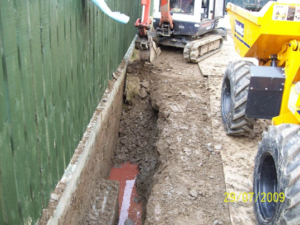 The Challenge:
The Challenge:
Following damage to an oil-feed line, approximately 2000 litres of kerosene was lost to ground at the rear of a residential property. Oil hit the shallow groundwater and started to migrate in to the local watercourse. The challenge came firstly to restrict the spread of kerosene down stream to a fishery, then remediate the site.
The Solution:
Emergency mitigation measures were deployed to prevent migration of kerosene further off-site using absorbent booms deployed in strategic locations. A sandbag barrier wall was constructed along the banking to divert the water flow away from the impacted bank, absorbents were then placed behind the barrier to intercept kerosene before it reached the watercourse.
Emergency Works
Following an initial site assessment, a drilling rig was rapidly mobilised to site to facilitate assessment of the groundwater conditions. Groundwater extraction boreholes were installed at the same time as the assessment works; one borehole was positioned to extract kerosene from near the spill source, and 3 further boreholes positioned to intercept contamination before it reached the water course.
Due to restricted site access a bespoke water treatment system was designed and installed on site. Borehole pumps were installed to extract both free and dissolved phase kerosene from the ground water. The pumps were run on a programmed schedule to enable the system to run 24/7. A self-regulating treatment system was installed to reduce supervision requirements and therefore create cost savings. The system comprised an oil-water separator followed by a carbon filters, all installed within a garden shed with pipes and cables buried to enable full use of the garden by the homeowner.
Weekly monitoring of the system and watercourse were carried for the duration of the project. Upon completion of the project the water treatment equipment and buried pipe work was removed from the property and the resident’s garden re-instated to pre-spill conditions. Works were concluded with a scientifically robust verification report.
Duration: 5 monthsI
